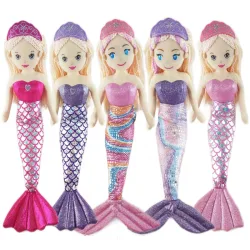Aspects of dolls
2024-02-19
A doll is a three-dimensional figurine or representation of a human, humanoid, or animal figure, typically used as a toy for play, decoration, or collectible purposes. Dolls come in various shapes, sizes, and materials, and they have been a part of human culture for centuries. Here are some key aspects of dolls:
1. Materials:
- Cloth Dolls: Made from fabric and often stuffed with soft materials such as cotton or synthetic fibers. Rag dolls are a common type of cloth doll.
- Plastic Dolls: Often made from materials like polyethylene or PVC. Many fashion dolls, such as Barbie, are made of plastic.
- Wooden Dolls: Carved from wood and can be simple or intricately detailed. Traditional wooden dolls are found in many cultures.
- Porcelain Dolls: Made from porcelain or bisque. These dolls are known for their delicate features and are often collectibles.
2. Articulation:
- Articulated Dolls: Have movable joints that allow the limbs and sometimes the head to move. This enhances the playability of the doll.
- Non-Articulated Dolls: Have fixed positions and cannot be posed. These are often used as decorative items or collectibles.
3. Types of Dolls:
- Fashion Dolls: Such as Barbie and Ken, known for their fashionable clothing and accessories.
- Baby Dolls: Resemble infants or toddlers and are often popular with young children for nurturing play.
- Collectible Dolls: Crafted with attention to detail and may be part of limited editions or artistic collections.
- Action Figures: Represent characters from movies, TV shows, or comic books and are popular among collectors and fans.
4. Cultural and Historical Significance:
- Cultural Traditions: Dolls have been used in various cultural traditions, such as ceremonial dolls, storytelling dolls, or dolls representing historical figures.
- Historical Dolls: Some dolls are designed to represent specific periods in history, providing educational value.
5. Play and Education:
- Imaginative Play: Dolls often serve as companions for children during imaginative play, fostering creativity and storytelling.
- Educational Dolls: Some dolls are designed to teach specific skills, such as dolls with features for learning to dress or dolls representing diverse cultures.
6. Collecting:
- Doll Collecting: Many people collect dolls as a hobby. Collectors may focus on specific types, brands, or historical periods.
7. Customization:
- DIY and Custom Dolls: Some dolls are designed to be customized, allowing individuals to create unique characters through painting, sewing, or other creative processes.
8. Interactive and Electronic Dolls:
- Interactive Features: Modern dolls may have electronic features, such as sound, movement, or sensors, enhancing the interactive experience for children.
Dolls hold a special place in the world of toys and can be cherished as sentimental items, cultural artifacts, or artistic creations. They continue to evolve with changing trends and technologies, offering new possibilities for play and expression.



